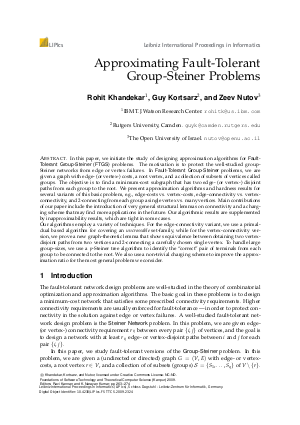Approximating Fault-Tolerant Group-Steiner Problems
Authors Rohit Khandekar, Guy Kortsarz, Zeev Nutov
-
Part of:
Volume:
IARCS Annual Conference on Foundations of Software Technology and Theoretical Computer Science (FSTTCS 2009)
Part of: Series: Leibniz International Proceedings in Informatics (LIPIcs)
Part of: Conference: IARCS Annual Conference on Foundations of Software Technology and Theoretical Computer Science (FSTTCS) - License:
 Creative Commons Attribution-NonCommercial-NoDerivs 3.0 Unported license
Creative Commons Attribution-NonCommercial-NoDerivs 3.0 Unported license
- Publication Date: 2009-12-14
File

PDF
LIPIcs.FSTTCS.2009.2324.pdf
- Filesize: 217 kB
- 12 pages
Document Identifiers
Subject Classification
Keywords
- Fault-tolerance
- group Steiner problem
- edge-disjointness
- vertex-disjointness
- approximation
- connectivity
Metrics
- Access Statistics
-
Total Accesses (updated on a weekly basis)
0PDF Downloads0Metadata Views
Abstract
In this paper, we initiate the study of designing approximation algorithms for
{\sf Fault-Tolerant Group-Steiner} ({\sf FTGS}) problems. The motivation is to protect
the well-studied group-Steiner networks from edge or vertex failures.
In {\sf Fault-Tolerant Group-Steiner} problems, we are given a graph with edge- (or vertex-) costs,
a root vertex, and a collection of subsets of vertices called groups. The objective is to find a
minimum-cost subgraph that has two edge- (or vertex-) disjoint paths from each group to the root.
We present approximation algorithms and hardness results for several variants of this basic problem, e.g.,
edge-costs vs. vertex-costs, edge-connectivity vs. vertex-connectivity,
and $2$-connecting from each group a single vertex vs. many vertices.
Main contributions of our paper include the introduction
of very general structural lemmas on connectivity and a charging scheme that may find more applications in the future.
Our algorithmic results are supplemented by inapproximability results, which are tight in some cases.
Our algorithms employ a variety of techniques.
For the edge-connectivity variant, we use a primal-dual based
algorithm for covering an {\em uncros\-sable} set-family, while for the vertex-connectivity version,
we prove a new graph-theoretic lemma that shows equivalence between obtaining two vertex-disjoint paths
from two vertices and $2$-connecting a carefully chosen single vertex. To handle large group-sizes,
we use a $p$-Steiner tree algorithm to identify the ``correct'' pair of terminals from each group to be
connected to the root. We also use a non-trivial charging scheme
to improve the approximation ratio for the most general problem we consider.
Cite As Get BibTex
Rohit Khandekar, Guy Kortsarz, and Zeev Nutov. Approximating Fault-Tolerant Group-Steiner Problems. In IARCS Annual Conference on Foundations of Software Technology and Theoretical Computer Science. Leibniz International Proceedings in Informatics (LIPIcs), Volume 4, pp. 263-274, Schloss Dagstuhl – Leibniz-Zentrum für Informatik (2009)
https://doi.org/10.4230/LIPIcs.FSTTCS.2009.2324
BibTex
@InProceedings{khandekar_et_al:LIPIcs.FSTTCS.2009.2324,
author = {Khandekar, Rohit and Kortsarz, Guy and Nutov, Zeev},
title = {{Approximating Fault-Tolerant Group-Steiner Problems}},
booktitle = {IARCS Annual Conference on Foundations of Software Technology and Theoretical Computer Science},
pages = {263--274},
series = {Leibniz International Proceedings in Informatics (LIPIcs)},
ISBN = {978-3-939897-13-2},
ISSN = {1868-8969},
year = {2009},
volume = {4},
editor = {Kannan, Ravi and Narayan Kumar, K.},
publisher = {Schloss Dagstuhl -- Leibniz-Zentrum f{\"u}r Informatik},
address = {Dagstuhl, Germany},
URL = {https://drops.dagstuhl.de/entities/document/10.4230/LIPIcs.FSTTCS.2009.2324},
URN = {urn:nbn:de:0030-drops-23243},
doi = {10.4230/LIPIcs.FSTTCS.2009.2324},
annote = {Keywords: Fault-tolerance, group Steiner problem, edge-disjointness, vertex-disjointness, approximation, connectivity}
}
